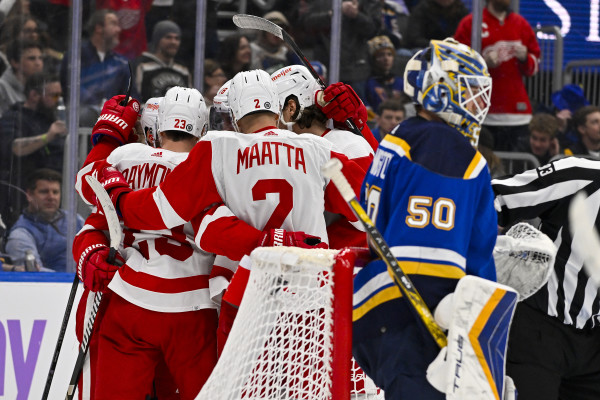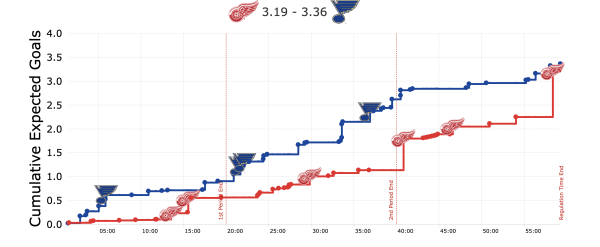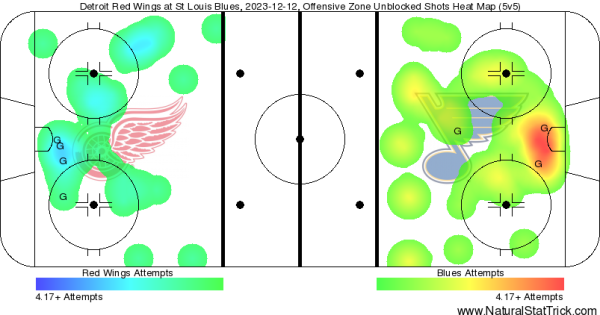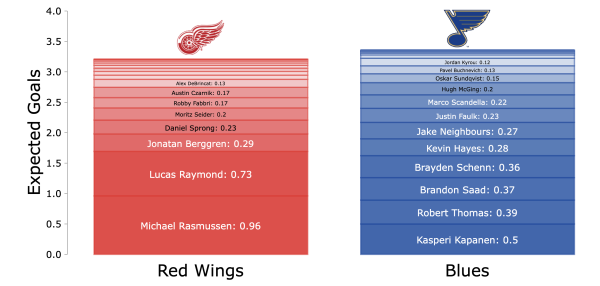
A dive into the underlying numbers from the Detroit Red Wings 6-4 win over the St. Louis Blues Tuesday night
A dive into the underlying numbers from the Detroit Red Wings 6-4 win over the St. Louis Blues Tuesday night
Last night in St. Louis, the Detroit Red Wings (without the services of Dylan Larkin, J.T. Compher, David Perron, and Klim Kostin) won a 6-4 decision over the St. Louis Blues. For the undermanned Red Wings, it was more a case of survival than dominance, but the two points count the same. For a better sense of how this game played out, let's take a look at the underlying numbers that defined the Detroit victory.

The Big Picture
-By all situations expected goals (per MoneyPuck), the Red Wings were out-chanced 3.19-3.36, but even that figure (which factors in Michael Rasmussen's empty-net goal) is a bit deceptive. MoneyPuck's Deserve to Win O'Meter had the Blues at a 66.9% chance of victory.
This was a game St. Louis controlled from start to finish. At the end of the first, the Blues led 0.903-0.564 by xG, but Detroit had a 2-1 lead on the scoreboard. By the end of the second, St. Louis led 4-2 and 2.619-1.133 by xG. Prior to Rasmussen's empty-netter, the Red Wings trailed 3.321-2.25 on xG but had rallied to lead 5-4.

Only three Red Wings finished the night at more than a 50% share of on-ice expected goals at five-on-five: Olli Maatta (88.54%), Daniel Sprong (78.51%), and Rasmussen (65.37%).
-The below heat map (of five-on-five unblocked shots, courtesy of Natural Stat Trick) shows that St. Louis did a much better job of creating offense, though both sides were able to generate chances and goals from the inner slot. At five-on-five, Detroit earned a 37.04% CorsiFor, a 39.02% share of scoring chances, a 33.33% share of high-danger chances, and a 35.75% share of expected goals.

When you put all that together, the numbers are telling us that this was a game the Red Wings stole. Normally, that sounds like a slight, but, without your top two centers on the road for the second leg of a back-to-back, it's a commendation.
Individual Impacts
-Rasmussen led Detroit by individual xG (0.96), scored a goal, gave an assist, and posted a 65.37% share of on-ice xG at five-on-five. Less empirically, he was outstanding physically for the Red Wings—making a major impact with his puck protection and assertiveness on the forecheck and off the cycle.

-Detroit went with 11 forwards and seven defensemen against in St. Louis. Up front, that meant using two (more or less) regular lines (neither of which was all that effective) with a lot of mixing and matching behind that.
Patrick Kane, Joe Veleno, and Alex DeBrincat were the Red Wings' busiest line at five-on-five, playing 9:12 together. The trio were out-chanced 0.114-0.377 by xG in those minutes (a 23.2% share) while being outscored 1-0.
The other semi-regular line was Lucas Raymond, Andrew Copp, and Robby Fabbri. That unit played 7:51 together at five-on-five, outscoring St. Louis 1-0 but getting out-chanced by xG 0.156-0.304 (a 33.9% share).
Behind those two, seven different lines played between 1:30 and 3:30 together. Those were (from greatest usage to least) Austin Czarnik-Christian Fischer-Jonatan Berggren, Lucas Raymond-Rasmussen-Sprong, Berggren-Rasmussen-Sprong, Rasmussen-Fischer-Sprong, Raymond-Veleno-Fabbri, Fabbri-Copp-Berggren, and Fabbri-Copp-Rasmussen. Each of the first three of those lines out-scored St. Louis 1-0.
-Amongst the seven defensemen, Detroit deployed two regular pairs, then rotated a number of different partnerships behind that.
Tuesday was a very difficult night for Jake Walman and Moritz Seider. They played 10:14 at five-on-five and were outscored 3-0 while putting up just a 1.0% share of on-ice xG. It must be said that Walman has not played his sharpest hockey of the year in the last two weeks, and it's hard not to think that he might still be battling the injury he sustained in Sweden.
Ben Chiarot and Jeff Petry were the next busiest Red Wing pairing at 8:22 together at five-on-five, and they earned much better results than Walman and Seider. They weren't on the ice for a goal in either direction, but they enjoyed a 60.8% share of on-ice xG.
Behind that top four, six different partnerships played between two and five minutes at five-on-five. Those pairs were (again from greatest usage to least) Maatta-Justin Holl, Chiarot-Holl, Shayne Gostisbehere-Maatta, Gostisbehere-Holl, Walman-Holl, and Walman-Chiarot.
-In net, Ville Husso was solid if not spectacular. He made 33 saves on 37 shots, giving up four goals on 3.357 xG against. That rounds out to a -0.65 Goals Saved Above Expected, which might be a bit harsh but also sounds roughly in line with Husso's effort.
However, even if he was far from dominant, Husso was head and shoulders better than Jordan Binnington in the opposite crease. Binnington made just 26 saves on 31 shots, allowing five goals on 2.25 xG for a -2.75 Goals Saved Above Expected.
Sometimes goaltending can be a bit like the old saying about fleeing a bear. You don't have to be faster than the bear; you just have to be faster than the guy next to you. Husso didn't exactly redeem himself after some recent challenging performances, but he was better than Binnington, and that was enough to get the victory.
Also from THN Detroit
Does Alex Lyon Deserve a Bigger Share of Starts than Ville Husso?
Red Wings 3, Stars 6: Detroit Stumbles in First Game Without Larkin
David Perron Receives Six Game Suspension for Attempt at Avenging Dylan Larkin's Injury

